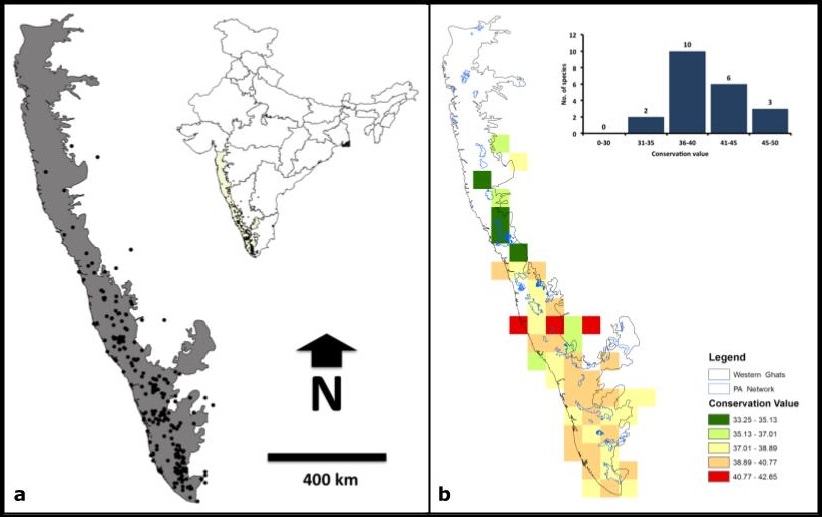- Researchers assessed the distribution of rattan palms in the Western Ghats, a biodiversity hotspot.
- Three species, harvested for making cane products, were found to have a narrow home range and warrant being listed as endangered.
- Five micro-hotspots of rattan diversity were identified within the Western Ghats.
If there is one material that finds immense use in our indoor and outdoor furnishings, besides wood, it is the cane. Sourced from a tall, climbing palm called the rattan, cane’s supply is almost entirely met with wild-growing rattan. And it too faces the same threat as wood – overexploitation. Now, scientists worried about rattan’s overuse have mapped its distribution in the Western Ghats of India and come up with conservation strategies to save it from going extinct.
India is home to 61 species of rattan palms, scattered across peninsular India, the northeastern states, and the Andaman and Nicobar Islands. Of these, 19 species are endemic to the Western Ghats. Two others are restricted to the Western Ghats of India but are also found in the neighbouring island nation of Sri Lanka. N.A. Aravind, a conservation ecologist with the Ashoka Trust for Research in Ecology and the Environment (ATREE), Bengaluru and his colleagues mapped the geographical distribution of these 21 endemic species.
The researchers collated their own field data with records from published works on the location of each rattan species and created a map of their distribution. To better comprehend the pattern of this distribution, the researchers divided the Western Ghats into three zones – northern (Maharashtra), central (Karnataka) and southern (Kerala and Tamil Nadu). This showed them that the northern Western Ghats are a rattan-poor zone while the central and southern parts are rich with 15 and 19 different species of rattan, respectively.

Next, they assigned each rattan species with a ‘conservation value’ – an indicator of the level of protection a species needs. To calculate this, they considered five factors – the extent of occurrence of a species, its biology, the pressure of harvesting, the number of habitat types where it grows and its range of elevation.
The maximum value a species could be assigned was 50. Species that came closer to this were naturally the ones that have a narrow distribution range (vertically or horizontally) and are harvested commercially for making cane products. These require more protection than species with lower conservation values, the researchers concluded.
Three species endangered
Three species stood out with a value of more than 45 – Calamus neelagiricus, C. vattayila, and C. pseudofeanus. The researchers think these three deserve a status of ‘endangered’ on the IUCN Red List. These are also single-stemmed species, and this aspect of their biology makes them more vulnerable to extinction. Single-stemmed species can be harvested just once whereas multi-stemmed species can be harvested over and over for raw material.
With a conservation value ranging between 30 and 45, the remaining 18 species fit either the ‘vulnerable’ or ‘near threatened’ categories, according to the study. All these, except one, are multi-stemmed species. These may survive harvesting for longer but their biology, on the whole, makes rattans susceptible to going extinct. The palms have separate male and female plants. Since it’s difficult to identify which is which until they flower after the age of five, mistakenly harvesting plants of one sex could prove disastrous for the whole population.
Hotspots within a hotspot
But to be able to guide rattan conservation, researchers first needed to identify sites rich in rattans in the Western Ghats biodiversity hotspot. Computer simulations revealed five micro-hotspots – two in the central and three in the southern Western Ghats. These are hotspots of high rattan diversity within the larger landscape, says Aravind. Biodiversity is not uniformly distributed across the Western Ghats, he adds, with regions of high and low diversity.

With the exception of some overlap, rattan micro-hotspots lie predominantly outside of protected areas. Aravind says that the state forest departments could bring these patches under the protected area network. “You can’t invest resources for conservation throughout the Western Ghats; the efforts can be concentrated in those particular regions,” Aravind said. His team plans to meet with forest officials in this regard.
Saving rattans is also crucial as the livelihood of about half a million people across rural parts of Southeast Asia depends on it. As most of the rattan’s supply comes from the wild, cultivating species of high economic value on private farms might ease off the burden on natural populations, Aravind suggests. Degenerated lands can also be populated with rattan, he says. This rattan can be supplied to the artisans instead of them relying on wild rattan.
But cultivating rattan has its own set of problems. Most rattan species prefer certain altitudes. Plus, their cultivation requires a steady supply of seeds, which is hard to come by as the plants are usually harvested before they flower. K.N. Ganeshaiah, an agricultural scientist at the University of Agricultural Sciences, who was not involved in the study, warns that the reproductive modes of rattans are complicated and less understood, making their domestication even harder. Otherwise, he wrote in an email to Mongabay-India, the study is an interesting effort to identify the species-rich areas of rattans.
Sandeep Yadav, of the Advanced Research Centre for Bamboo and Rattan at Aizawl in Mizoram, said that studies of a similar nature are required to assess the loss or gain of the distribution range of the different rattan species in Northeast India, too.

Citations:
- Joshi M., Charles B., Ravikanth G., & Aravind, N.A. (2017). Assigning conservation value and identifying hotspots of endemic rattan diversity in the Western Ghats, India. Plant Diversity, 39: 263–272, DOI: http://dx.doi.org/10.1016/j.pld.2017.08.002
- Raj H., Yadav S., & Bisht, N. S. (2014). Current status, issues and conservation strategies for Rattans of North-East India. Tropical Plant Research, 1(2): 01–07.